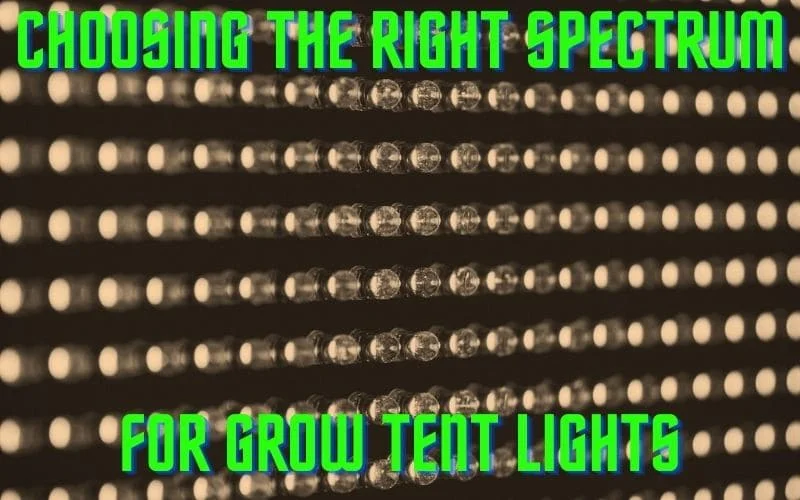Choosing the Right Spectrum for Grow Tent Lights: 4 Insights

Introduction
You’re about to embark on an exciting journey: growing plants in your indoor space. Whether it’s for a personal hobby or a serious endeavor, one key factor to consider is choosing the right spectrum for your grow tent lights. By understanding the different light spectrums available and their impact on plant growth, you can make an informed decision that will optimize your plants’ development and yield. Let’s dive into the fascinating world of light spectrums and how they can transform your indoor growing experience.
Full Spectrum
Overview
Full-spectrum grow lights are designed to mimic natural sunlight, providing a complete range of light wavelengths that are essential for plant growth. These lights emit wavelengths across the entire visible spectrum, from blue to red and everything in between. This comprehensive illumination is beneficial for all stages of plant growth, from seedling to flowering, making it a versatile choice for indoor gardening.
Red Spectrum
Overview
When it comes to the red light spectrum in plant growth, it plays a crucial role especially during the flowering and fruiting stages. The wavelength of red light stimulates the production of key pigments such as chlorophyll and carotenoids, as well as compounds like phytochrome, which are essential for promoting flowering and fruit development. These specific wavelengths trigger photomorphogenic responses in plants, influencing their growth and developmental processes.
Choosing red spectrum grow lights requires careful consideration of the specific needs of plants during their flowering phase. Different plant species have varying requirements for red light intensity and duration during flowering. For instance, long-day plants may require more red light exposure during the flowering phase compared to short-day plants. It’s important to tailor the red light spectrum to match the natural environmental conditions of the plant species being cultivated in order to optimize their flowering and fruiting processes.
The impact of red spectrum grow lights on the flowering and fruiting stages goes beyond just the quantity of light. The quality and intensity of red light can influence the timing of flowering, the formation of floral structures, and the overall yield and quality of the harvested fruits. By understanding the specific light requirements of plants during their flowering and fruiting stages, growers can strategically utilize red spectrum grow lights to enhance productivity and achieve higher quality yields.
Blue Spectrum
Overview
Blue spectrum lighting is an essential factor in the early stages of plant growth, especially during the vegetative phase. It plays a crucial role in influencing the development of strong, healthy foliage by stimulating chlorophyll production and providing vital support for photosynthesis. The utilization of blue spectrum grow lights sets the stage for robust plant growth, preparing the green companions for a flourishing future. These lights have proven to be indispensable in the horticultural world, offering a wide range of benefits that contribute to the overall well-being of plants.
During the vegetative phase, the blue spectrum of light influences the plants’ ability to produce strong and healthy foliage. This spectral range optimally supports the process of chlorophyll production, which is vital for the plants’ overall growth and development. Furthermore, the stimulation of photosynthesis by blue spectrum lighting enhances the plants’ ability to convert light energy into chemical energy, facilitating their growth and productivity.
- Enhances Chlorophyll Production: The specific wavelengths of blue spectrum light have been proven to enhance chlorophyll production, contributing to the rich green coloration of leaves and the overall health of the plant.
- Supports Photosynthesis: Blue spectrum lighting provides essential support for the process of photosynthesis, enabling plants to efficiently convert light energy into chemical energy, which fuels their growth.
- Stimulates Healthy Foliage Development: The influence of blue spectrum light promotes the development of strong and vibrant foliage, ensuring that the plants are well-equipped for the subsequent stages of growth.
- Promotes Robust Plant Growth: By facilitating chlorophyll production and supporting photosynthesis, blue spectrum lighting sets the foundation for robust and healthy plant growth, laying the groundwork for a thriving garden or crop.
White Spectrum
Overview
The white light spectrum is a balanced combination of red, blue, and other wavelengths, offering a versatile lighting solution for all stages of plant growth. This neutral illumination fosters overall plant health and can be an excellent choice for growers who want a single, all-purpose lighting solution. When considering white spectrum grow lights, remember that their versatility allows for seamless transitions between different growth phases, accommodating the changing needs of your plants.
Conclusion
Choosing the right spectrum for your grow tent lights is a decision that can significantly impact the success of your indoor gardening endeavors. By understanding the unique properties of full spectrum, red spectrum, blue spectrum, and white spectrum lighting, you can tailor your lighting setup to meet the specific needs of your plants at each growth stage. With the right spectrum in place, you’re not just providing light; you’re nurturing the growth, health, and vitality of your green companions. So, which spectrum will you choose to illuminate your indoor garden?


